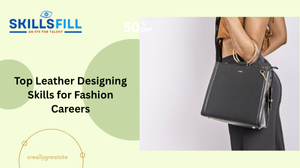Introduction
Leather has long been a symbol of luxury and durability in the fashion world. From runway-ready jackets and high-end handbags to artisanal shoes and sleek accessories, well-crafted leather products command respect and premium prices. As a result, leather design skills are in high demand among fashion houses, boutique labels, and independent artisans alike. Mastering these skills can open doors to exciting career paths, whether you aspire to work for established brands or launch your own label. In this article, we explore the essential abilities every aspiring leather designer should cultivate, ensuring your creativity meets industry standards and consumer expectations.
Types of Leather Used in Fashion
Understanding the various leather types is fundamental for any designer. Each category offers distinct characteristics that influence the look, feel, and performance of the final product.
- Full-Grain Leather
The highest quality, retaining the animal’s natural grain and strength. Ideal for premium handbags and footwear, full-grain leather develops a rich patina over time. - Top-Grain Leather
Slightly sanded to remove imperfections, it remains strong and more uniform in appearance. Commonly used in mid- to high-range accessories and apparel. - Genuine Leather
Reconstituted from lower-grade hides, it’s budget-friendly but less durable. Often found in entry-level bags and belts. - Split Leather (Suede & Nubuck)
Split from the lower layers of hide, suede, and nubuck offer a soft, velvety finish. Popular for jackets, shoes, and interior linings. - Eco-Leather & Vegan Alternatives
Rising consumer demand for sustainability has spurred innovations like pineapple (Piñatex), cork, and mushroom-based leathers. These materials reduce environmental impact while still offering stylish solutions.
Basics of Leather Pattern Making
Pattern making transforms your design concepts into precise templates for cutting and assembly. In leather work, precision is critical: mistakes can be costly, as leather cannot be patched or resewn easily like fabric.
- Initial Sketch and Measurements
Start with a detailed flat sketch. Note dimensions for each panel, seam allowances, and stitch lines. Accurate measurements of hardware placement ensure functionality and aesthetics. - Drafting the Paper Pattern
Transfer your sketch onto pattern paper. Use rulers, French curves, and hip curves to draw smooth lines. Label each piece clearly (e.g., “Front Panel,” “Strap,” “Lining”). - Test with Muslin or Kraft Paper
Before cutting leather, assemble a mock-up using inexpensive fabric or kraft paper. This step checks fit, alignment, and proportions without wasting expensive material. - Marking Cut Lines and Notches
Include notches, drill points, and fold lines. Consistent marking ensures that multiple parts fit perfectly during assembly.
Manual vs. Digital Pattern Creation
The landscape of pattern making is evolving. While traditional manual methods remain popular for their tactile feedback, digital techniques offer speed and scalability.
- Manual Pattern Making
- Pros: Immediate hands-on adjustments, deeper understanding of material drape and behavior.
- Cons: Time-consuming, less efficient for large production runs, prone to human error.
- Pros: Immediate hands-on adjustments, deeper understanding of material drape and behavior.
- Digital Pattern Making
- Pros: Software like AutoCAD and Gerber AccuMark enables precise drafting, easy grading for multiple sizes, and rapid revisions. Patterns can be shared globally and archived with minimal storage space.
- Cons: Steeper learning curve, initial software investment, may lack intuitive feel for material properties.
- Pros: Software like AutoCAD and Gerber AccuMark enables precise drafting, easy grading for multiple sizes, and rapid revisions. Patterns can be shared globally and archived with minimal storage space.
In practice, many designers combine both approaches: starting with hand-drawn concepts before refining and grading patterns digitally.
CAD and Digital Design Tools for Leather
Mastering computer-aided design (CAD) tools is a game-changer in modern leather fashion. These platforms streamline workflow, enhance accuracy, and improve collaboration across teams.
- Adobe Illustrator
Widely used for vector illustrations, it allows designers to create clean tech packs, flat sketches, and initial artwork for embossing or printing. - Rhino 3D
Ideal for 3D modeling of hardware, bag structures, and shoe lasts. Rhino’s precise geometry tools help visualize complex shapes before prototyping. - Optitex & Gerber
Specialized in pattern drafting and grading, these systems integrate fabric simulation to preview how leather will drape and conform to curves. - Clo3D / Browzwear
Though more common in apparel, these 3D simulation tools are emerging in leather design, enabling virtual prototyping that conserves time and material waste.
By investing in these digital skills, you position yourself as an efficient, tech-savvy designer ready for both small-scale couture and large-volume production.
Market Trends and Consumer Preferences
Finally, staying abreast of market trends ensures your designs resonate with buyers and retail partners.
- Sustainability and Ethics
Consumers increasingly favor ethically sourced and eco-friendly leather. Certifications like LWG (Leather Working Group) signal responsible practices, boosting brand credibility. - Customization and Personalization
On-demand engraving, monogramming, and bespoke fittings cater to individual tastes. Designers skilled in flexible production can tap niche luxury markets. - Minimalist and Functional Design
Clean lines, multi-functional pockets, and modular accessories reflect modern lifestyles. Practical yet stylish pieces appeal to urban consumers seeking versatility. - Retro Revival
Vintage-inspired silhouettes, distressed finishes, and heritage hardware evoke nostalgia. Designers who balance classic charm with contemporary touches capture cross-generational interest.
By monitoring runway shows, trade fairs like Lineapelle, and social media insights, you can anticipate shifts in color palettes, finishes, and preferred silhouettes.
Conclusion
Building a career in leather fashion design requires a blend of creative vision, technical prowess, and industry awareness. From understanding the nuances of different leather types to mastering pattern-making both manual and digital and leveraging CAD tools, each skill enhances your value as a designer. Equally important is your ability to read market trends and respond to evolving consumer tastes.
By honing these core competencies and adopting sustainable practices, you’ll not only craft standout leather goods but also position yourself as a trusted professional in a competitive field. Embrace continuous learning, seek industry mentorship, and build a portfolio that reflects both your craftsmanship and your strategic insight into the world of leather fashion.

Leave a Reply